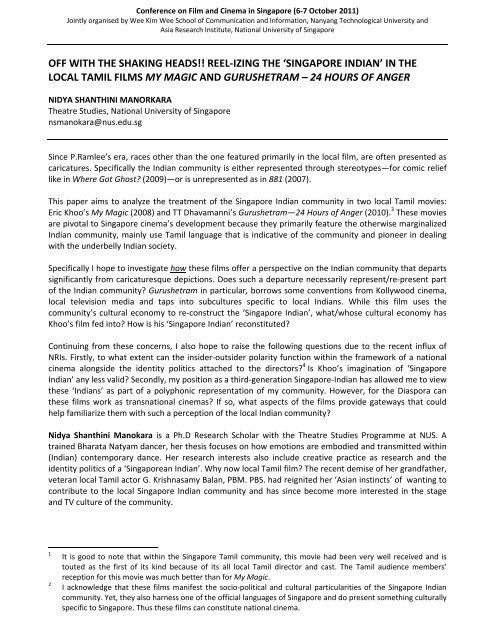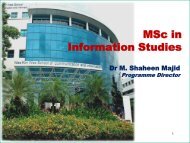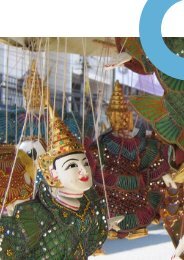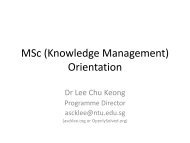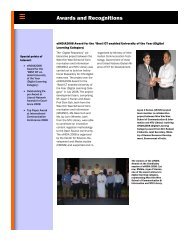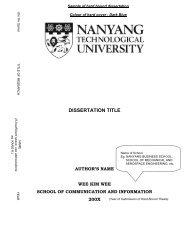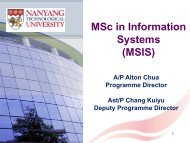Programme and Abstracts 4 Oct 2011 - WKWSCI Home - Nanyang ...
Programme and Abstracts 4 Oct 2011 - WKWSCI Home - Nanyang ...
Programme and Abstracts 4 Oct 2011 - WKWSCI Home - Nanyang ...
Create successful ePaper yourself
Turn your PDF publications into a flip-book with our unique Google optimized e-Paper software.
Conference on Film <strong>and</strong> Cinema in Singapore (6‐7 <strong>Oct</strong>ober <strong>2011</strong>)<br />
Jointly organised by Wee Kim Wee School of Communication <strong>and</strong> Information, <strong>Nanyang</strong> Technological University <strong>and</strong><br />
Asia Research Institute, National University of Singapore<br />
OFF WITH THE SHAKING HEADS!! REEL‐IZING THE ‘SINGAPORE INDIAN’ IN THE<br />
LOCAL TAMIL FILMS MY MAGIC AND GURUSHETRAM – 24 HOURS OF ANGER<br />
NIDYA SHANTHINI MANORKARA<br />
Theatre Studies, National University of Singapore<br />
nsmanokara@nus.edu.sg<br />
Since P.Ramlee’s era, races other than the one featured primarily in the local film, are often presented as<br />
caricatures. Specifically the Indian community is either represented through stereotypes—for comic relief<br />
like in Where Got Ghost (2009)—or is unrepresented as in 881 (2007).<br />
This paper aims to analyze the treatment of the Singapore Indian community in two local Tamil movies:<br />
Eric Khoo’s My Magic (2008) <strong>and</strong> TT Dhavamanni’s Gurushetram—24 Hours of Anger (2010). 3 These movies<br />
are pivotal to Singapore cinema’s development because they primarily feature the otherwise marginalized<br />
Indian community, mainly use Tamil language that is indicative of the community <strong>and</strong> pioneer in dealing<br />
with the underbelly Indian society.<br />
Specifically I hope to investigate how these films offer a perspective on the Indian community that departs<br />
significantly from caricaturesque depictions. Does such a departure necessarily represent/re‐present part<br />
of the Indian community Gurushetram in particular, borrows some conventions from Kollywood cinema,<br />
local television media <strong>and</strong> taps into subcultures specific to local Indians. While this film uses the<br />
community’s cultural economy to re‐construct the ‘Singapore Indian’, what/whose cultural economy has<br />
Khoo’s film fed into How is his ‘Singapore Indian’ reconstituted<br />
Continuing from these concerns, I also hope to raise the following questions due to the recent influx of<br />
NRIs. Firstly, to what extent can the insider‐outsider polarity function within the framework of a national<br />
cinema alongside the identity politics attached to the directors 4 Is Khoo’s imagination of ‘Singapore<br />
Indian’ any less valid Secondly, my position as a third‐generation Singapore‐Indian has allowed me to view<br />
these ‘Indians’ as part of a polyphonic representation of my community. However, for the Diaspora can<br />
these films work as transnational cinemas If so, what aspects of the films provide gateways that could<br />
help familiarize them with such a perception of the local Indian community<br />
Nidya Shanthini Manokara is a Ph.D Research Scholar with the Theatre Studies <strong>Programme</strong> at NUS. A<br />
trained Bharata Natyam dancer, her thesis focuses on how emotions are embodied <strong>and</strong> transmitted within<br />
(Indian) contemporary dance. Her research interests also include creative practice as research <strong>and</strong> the<br />
identity politics of a ‘Singaporean Indian’. Why now local Tamil film The recent demise of her gr<strong>and</strong>father,<br />
veteran local Tamil actor G. Krishnasamy Balan, PBM. PBS. had reignited her ‘Asian instincts’ of wanting to<br />
contribute to the local Singapore Indian community <strong>and</strong> has since become more interested in the stage<br />
<strong>and</strong> TV culture of the community.<br />
1<br />
2<br />
It is good to note that within the Singapore Tamil community, this movie had been very well received <strong>and</strong> is<br />
touted as the first of its kind because of its all local Tamil director <strong>and</strong> cast. The Tamil audience members’<br />
reception for this movie was much better than for My Magic.<br />
I acknowledge that these films manifest the socio‐political <strong>and</strong> cultural particularities of the Singapore Indian<br />
community. Yet, they also harness one of the official languages of Singapore <strong>and</strong> do present something culturally<br />
specific to Singapore. Thus these films can constitute national cinema.


